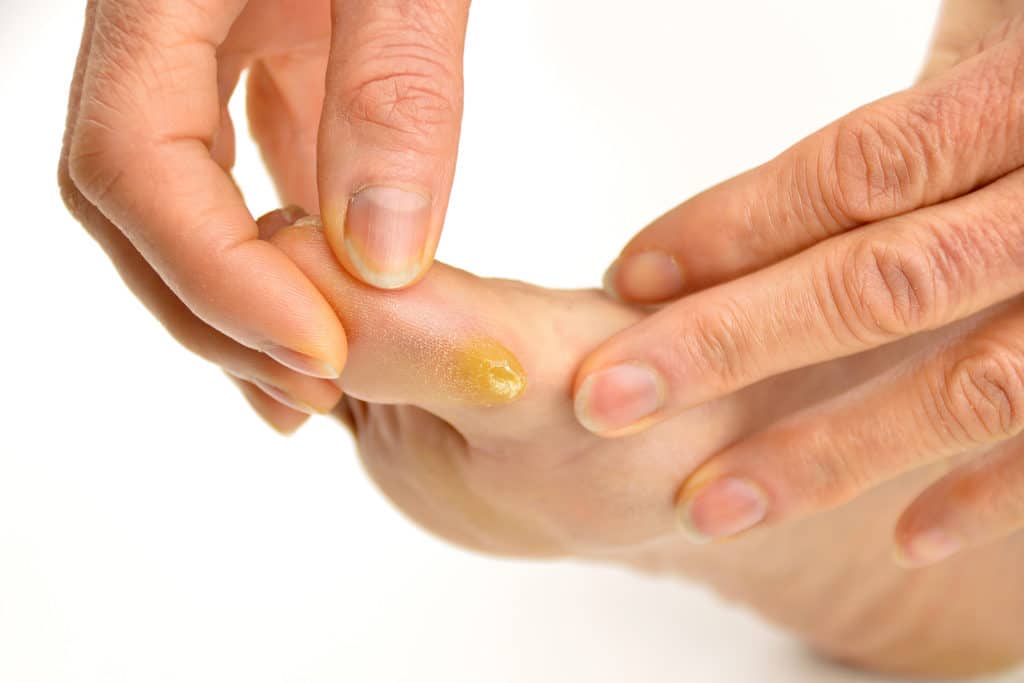The difference between corns and calluses
Corns and calluses are both common skin conditions that can cause discomfort and pain. They are often mistaken for each other, but the two have some key differences.
Corns and calluses result from repeated pressure or friction on the skin. Calluses develop from repeated friction, rubbing, pressure, and irritation on the skin. The skin’s natural defense to external pressure is to become thickened, leading to callus and corns, which if left untreated can become painful. Calluses may or may not be painful and can become painful over time as they thicken.
Corns and callus should always be treated professionally should the patient have conditions such as Diabetes or Rheumatoid Arthritis, as serious complications may develop.
At Waverley Clinic, we have seen many patients who are unsure whether they have a corn or callus, so here is some information to help you understand the difference between these two conditions and how to treat them.
What is a soft corn?
A corn is a small, hardened area of skin like a pellet that forms within the skin at areas of high pressure e.g on the knuckle joint of a toe or under the ball of the foot. Hard corns tend to be small and occur in areas of firm, hard skin or where there are calluses. Corns are usually round and have a raised bump in the centre with a smooth, hard surface surrounding it. They can be yellowish in colour and can range in size from small to large. Corns project into the tissue like an upturned cone, leading to pain when walking or pressure from shoes.
Another type of corn is called Soft Corn. Soft corns tend to be whitish in colour and have a rubbery texture. They commonly occur between the toes in areas of moist and sweaty skin. They may look like an open sore and can cause a surprisingly high level of pain.
Corns are caused by repeated friction or pressure on the skin, often from tight, ill-fitting shoes but not always.
What happens if you leave a corn untreated?
If you leave a corn untreated, it usually continues to increase in size week by week and can become increasingly painful and even make it difficult to walk. Corns can also cause discomfort when wearing shoes, as they can rub against the skin and cause further irritation. Untreated corns can lead to tissue break down under the corn leading to wound development and possible infection
How can a Podiatrist remove dead skin from a corn?
A Podiatrist may need to remove the corn through professional treatment. A podiatrist may recommend using a pumice stone to remove dead skin and prevent the recurrence of corns and calluses. It is important to seek medical attention if the corn is causing severe pain or discomfort. Individuals with certain medical conditions, such as diabetes, heart disease, or circulation problems, should not attempt to treat corns themselves and should see a Podiatrist.
Never try to remove corns using acid-based corn plasters. The burning of the skin is dangerous and can lead to serious tissue injury and breakdown.
What is a callus and hardened skin?
A callus is a larger, flattened area of thickened skin that forms on the hands or feet. Unlike a corn, it does not have a central core and may occur on any part of the foot or hand. Calluses are made up of layers of dead skin and again are usually caused by repeated pressure or friction on the skin, such as from playing an instrument or using hand tools for work.
Calluses can also be a result of pressure on certain high pressure or prominent areas of the foot such as bunions, prominent toes or the heel.
What does it mean when a callus hurts?
When a callus hurts, it is usually because of the increased pressure or friction on the skin. This can be caused by ill-fitting shoes, repetitive activities, or underlying medical conditions. It is important to address the cause of the callus in order to alleviate the pain and prevent further discomfort.
Check if you have a corn or callus
If you are unsure whether you have a corn or callus, there are a few key differences to look out for. Corns are usually smaller and have a distinct raised bump in the centre, while calluses tend to be larger and flatter. If you are experiencing pain, discomfort, or difficulty walking, it is important to consult with a medical professional, such as a Podiatrist, for proper diagnosis and treatment of corns and calluses.
Calluses corns treatment at Waverley Clinic
At Waverley Clinic, Jonathan, our skilled podiatrist, is committed to delivering comprehensive and personalised treatment for corns and calluses. We will assess the affected areas and remove the corns and calluses using a file or small blade – a painless procedure that leaves you feeling relieved and comfortable. Keeping the skin soft is crucial, so we recommend using soft insoles, soaking corns and calluses in warm water, and moisturising regularly.
To further enhance your care, we will apply a rich foot cream and offer advice on slowing the return of corns and calluses. For instance, we can create custom silicone toe separators to help prevent corns from forming between the toes. We also offer a wide range of specialised foot creams that are available for purchase. Our podiatrist can recommend the most suitable cream for your skin type, ensuring continued care and comfort at home. Be aware that treatments like salicylic acid can cause irritation to the surrounding skin and should not be used on cracked skin or by individuals with certain medical conditions.
We will also provide various treatment options, including custom orthotics and footwear recommendations, to help prevent their recurrence.
Our goal is to alleviate pain, improve foot function, and promote overall foot health for our patients. If you are experiencing discomfort or difficulty walking due to corns or calluses, don’t hesitate to schedule an appointment today; call us on 01252 716611.
With proper treatment and care, we can help you get back on your feet and pain-free. So don’t wait until the problem worsens – take care of your feet today.
A doctor may need to prescribe stronger medication or perform a procedure to remove the corn or callus safely. They can also help identify and address any underlying medical conditions that may be contributing to the problem.
Call our expert team at Waverley Clinic to fix your corns and calluses today!
We hope our blog on the difference between corns and calluses has helped. Don’t let those painful corns and calluses slow you down. Contact our friendly team at Waverley Clinic today to schedule an appointment with our skilled podiatrist. We will provide you with tailored treatment options to help alleviate pain, improve foot function, and promote overall foot health. With our expert care and dedication, we can help get you back on your feet and feeling comfortable.
So why wait? Call us today at 01252 716611 to book your consultation and take the first step towards healthy, happy feet.

